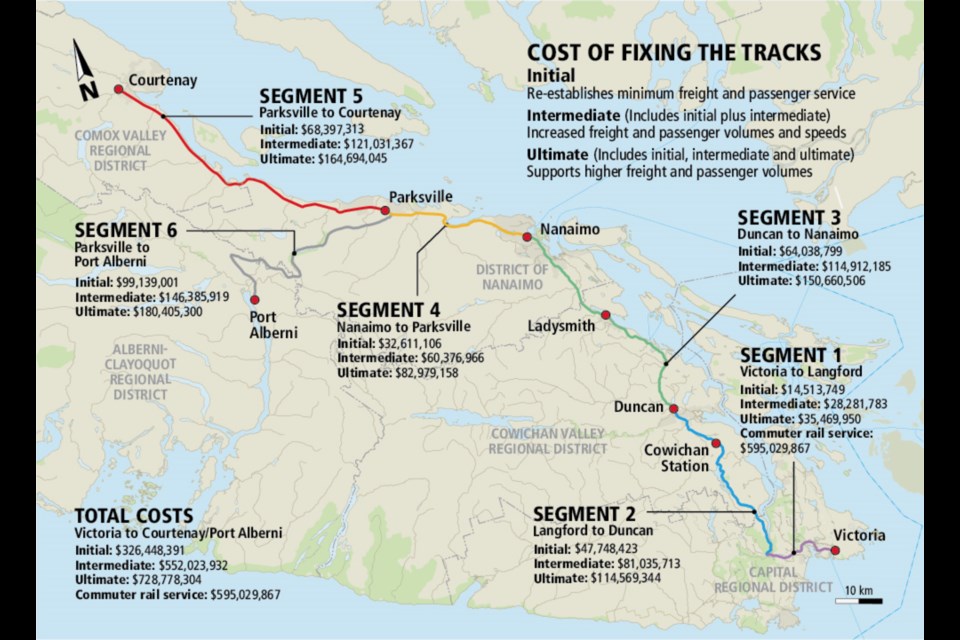A condition assessment of the Island Rail Corridor estimates that costs to get trains running again could range from $326 million to $729 million or more.
The study, released Tuesday, puts the price to introduce commuter rail service between Victoria and Westhills in Langford at $595 million.
WSP Canada Group Ltd. prepared the 108-page report on the track for B.C.’s Ministry of Transportation and Infrastructure. The main track runs 225 kilometres from Victoria to Courtenay. A section running west from Parksville to Port Alberni covers an additional 64 kilometres.
Rail industry experts reviewed track components and bridges on the corridor. Safety concerns about track condition ended Via passenger service in 2011.
A freight rail service is running from Wellcox Yard at the port of Nanaimo. Freight is transported to and from downtown Nanaimo via Seaspan Ferries Corp., mainly out of Annacis Island at Delta.
Estimates for the price of capital investment do not include costs to operate and maintain rail service, nor do they include environmental impacts.
Two pages in the report lists “high-level risks.” These include unidentified defects in the corridor’s bridges, possible acceleration in deterioration of bridges, hazards from rockfalls, implications of old underground mining operations, and changing demand.
The corridor is owned by the Island Rail Corridor Foundation and operated by the Southern Railway of Vancouver Island, which runs the freight service.
WSP’s report estimated how much it would cost to bring back both freight and passengers service.
The Transportation Ministry will use the analysis as it develops its South Island Transportation Strategy, expected to be released in June. That strategy includes various types of transportation, including rail, a ministry statement said Tuesday.
Andrea Thomas, manager of corridor development for the non-profit Island Rail Corridor Foundation, said that the group was pleased the report has been released. “We’ll just need a little bit of time to properly review its contents before we comment.”
As the land owner, the foundation had some input into the report but WSP did the assessment. “We didn’t really have any say in any of the numbers or the details of the actual report,” Thomas said.
In October of last year, Larry Stevenson, foundation chief executive, said he was optimistic that rail service would return to Vancouver Island.
The foundation is made up of a 12-member board, with five directors from First Nations and five from Island regional districts.
The capital region’s 13 mayors called for immediate action in February 2019 to see passenger trains operating between Langford and Victoria, an often congested road trip for motorists.
WSP said the road bed and track structure on the corridor is “generally in poor to fair condition. Bridges along the corridor range between poor to good depending on the age, location, and type of bridge.”
The at-grade crossings are typically in fair condition, but some are overgrown and need improved warning systems, the report said.
WSP recommends a three-stage approach to improvements.
The initial phase would establish minimum freight and passenger service. This would see between two and four passenger trains and two and four freight trains (with 10 to 20 car trains) per day.
The intermediate stage would allow four to eight passenger trains daily, four freight trains (10 to 20 cars) and faster speeds.
The ultimate category would see eight or more passenger trains and higher freight volumes.
Final costs, in 2020 dollars, for the entire corridor are estimated to be $326 million for the first phase, followed by $552 million for the intermediate phase. The ultimate stage would come in at $729 million.
The Victoria-Langford commute option is $595 million.
“Phasing the improvements allocates the appropriate amount of funding for the appropriate levels of demand,” the report said.
When rail volumes increase beyond the first stage, more capital would be needed for the intermediate phase, and the same situation would occur for the ultimate phase.
The report split the corridor into six segments, which “allows flexibility for phased improvements to be implemented where and when there is demand.”



